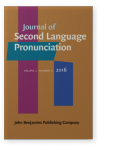Archer, Gemma
2022.
The Effects of Prestige Model Familiarity on Students’ Perceptions of and Interactions with Diverse English Accents. In
Theoretical and Practical Developments in English Speech Assessment, Research, and Training [
Second Language Learning and Teaching, ],
► pp. 67 ff.

Bao, Rian, Linkai Peng, Yingming Gao & Jinsong Zhang
2022.
2022 13th International Symposium on Chinese Spoken Language Processing (ISCSLP),
► pp. 394 ff.

Bao, Rian, Linkai Peng & Jinsong Zhang
2022.
2022 International Conference on Asian Language Processing (IALP),
► pp. 358 ff.

Bashori, Muzakki, Roeland van Hout, Helmer Strik & Catia Cucchiarini
2024.
I Can Speak
: improving English pronunciation through automatic speech recognition-based language learning systems
.
Innovation in Language Learning and Teaching ► pp. 1 ff.

Crowther, Dustin, Daniel R. Isbell & Hitoshi Nishizawa
2023.
Second language speech comprehensibility and acceptability in academic settings: Listener perceptions and speech stream influences.
Applied Psycholinguistics 44:5
► pp. 858 ff.

Crowther, Dustin, Pavel Trofimovich, Kazuya Saito & Talia Isaacs
2018.
LINGUISTIC DIMENSIONS OF L2 ACCENTEDNESS AND COMPREHENSIBILITY VARY ACROSS SPEAKING TASKS.
Studies in Second Language Acquisition 40:2
► pp. 443 ff.

Dai, Yuanjun & Zhiwei Wu
2022.
Mobile-assisted peer feedback on EFL pronunciation: Outcome effects, interactional processes, and shaping factors.
System 111
► pp. 102953 ff.

Dai, Yuanjun & Zhiwei Wu
2023.
Mobile-assisted pronunciation learning with feedback from peers and/or automatic speech recognition: a mixed-methods study.
Computer Assisted Language Learning 36:5-6
► pp. 861 ff.

Derwing, Tracey M. & Ronald I. Thomson
2019.
Reflections on the Development of L2 Pronunciation Research in Canada.
The Canadian Modern Language Review 75:4
► pp. 329 ff.

Foote, Jennifer A. & Pavel Trofimovich
2018.
Is It Because of My Language Background? A Study of Language Background Influence on Comprehensibility Judgments.
The Canadian Modern Language Review 74:2
► pp. 253 ff.

Han, Jiyoung & Kilryoung Lee
2023.
Validity Argument for Post-Entry Oral Performance Assessment for International Students in Korean Higher Education.
Modern English Education 24:1
► pp. 91 ff.

Hu, Xueyan, Li-Jen Kuo & L. Quentin Dixon
2022.
Effectiveness of interventions on improving English language learners’ intelligibility and comprehensibility: A meta-analytic review.
Language Teaching Research ► pp. 136216882211068 ff.

Huensch, Amanda & Charlie Nagle
2021.
The Effect of Speaker Proficiency on Intelligibility, Comprehensibility, and Accentedness in L2 Spanish: A Conceptual Replication and Extension of Munro and Derwing (1995a).
Language Learning 71:3
► pp. 626 ff.

Kautonen, Maria
2018.
Om hur finskspråkiga och svenskspråkiga lyssnare bedömer och värderar avancerade talares uttal av finlandssvenska.
Nordand 13:2
► pp. 131 ff.

Li, Peng, Florence Baills, Lorraine Baqué & Pilar Prieto
2023.
The effectiveness of embodied prosodic training in L2 accentedness and vowel accuracy.
Second Language Research 39:4
► pp. 1077 ff.

Lima, Edna F.
2016.
Comprehensibility and liveliness in nonnative student oral presentations before and after training: A mixed methods study.
System 63
► pp. 121 ff.

Mora, Joan C.
2022.
Accentedness and Comprehensibility in Non-native Listeners’ Perception of L2 Speech. In
Theoretical and Practical Developments in English Speech Assessment, Research, and Training [
Second Language Learning and Teaching, ],
► pp. 109 ff.

Nagle, Charles L. & Amanda Huensch
Nagle, Charles L. & Amanda Huensch
NAGLE, CHARLIE L., PAVEL TROFIMOVICH, MARY GRANTHAM O'BRIEN & SARA KENNEDY
2022.
Comprehensible to Whom? Examining Rater, Speaker, and Interlocutor Perspectives on Comprehensibility in an Interactive Context.
The Modern Language Journal 106:4
► pp. 675 ff.

Saito, Kazuya & Yuwei Liu
2022.
Roles of collocation in L2 oral proficiency revisited: Different tasks, L1 vs. L2 raters, and cross-sectional vs. longitudinal analyses.
Second Language Research 38:3
► pp. 531 ff.

Saito, Kazuya, Mai Tran, Yui Suzukida, Hui Sun, Viktoria Magne & Meltem Ilkan
2019.
HOW DO SECOND LANGUAGE LISTENERS PERCEIVE THE COMPREHENSIBILITY OF FOREIGN-ACCENTED SPEECH?.
Studies in Second Language Acquisition 41:5
► pp. 1133 ff.

Strachan, Lauren, Sara Kennedy & Pavel Trofimovich
Sun, Hui, Kazuya Saito & Jean‐Marc Dewaele
2024.
Cognitive and Sociopsychological Individual Differences, Experience, and Naturalistic Second Language Speech Learning: A Longitudinal Study.
Language Learning 74:1
► pp. 5 ff.

Taylor Reid, Kym, Mary Grantham O’Brien, Pavel Trofimovich & Allison Bajt
Taylor Reid, Kym, Pavel Trofimovich & Mary Grantham O’Brien
2022.
The Malleability of Listener Judgments of Second Language Speech. In
Theoretical and Practical Developments in English Speech Assessment, Research, and Training [
Second Language Learning and Teaching, ],
► pp. 11 ff.

Tergujeff, Elina
2023.
Second Language Learners Listening to their Peers: Is There a Shared L1 Effect for L2 Comprehensibility and Accentedness?.
European Journal of Applied Linguistics 0:0

Trofimovich, Pavel, Sara Kennedy & Josée Blanchet
2017.
Development of Second Language French Oral Skills in an Instructed Setting: A Focus on Speech Ratings.
Canadian Journal of Applied Linguistics 20:2
► pp. 32 ff.

Verbeke, Gil & Ellen Simon
2023.
Listening to accents: Comprehensibility, accentedness and intelligibility of native and non-native English speech.
Lingua 292
► pp. 103572 ff.

Xu, Ying, Mengjia Huang, Jin Chen & Yaqing Zhang
2023.
Investigating a shared-dialect effect between raters and candidates in English speaking tests.
Frontiers in Psychology 14

This list is based on CrossRef data as of 2 april 2024. Please note that it may not be complete. Sources presented here have been supplied by the respective publishers.
Any errors therein should be reported to them.
